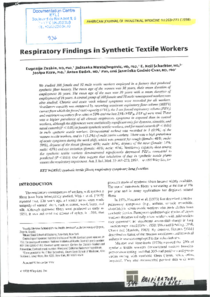Respiratory findings in synthetic textile workers

Zuskin, Eugenija ; Mustajbegovic, Jadranka ; Schachter, Neil E. ; Kern, Josipa ; Budak, Antun ; Godnic-Cvar, Jasminka
American Journal of Industrial Medicine
1998
33
3
263-273
case control study ; lung ; occupation disease relation ; respiratory diseases ; symptoms ; synthetic fibres ; textile ; ventilatory capacity
Occupational risks
English
Bibliogr.
A survey of respiratory health in Croatian synthetic fiber textile workers was conducted. The cohort consisted of 400 workers, 308 females, 18 to 61 years old, employed in a synthetic textiles factory at Zagreb, Croatia. The workers had been employed at the facility a mean of 16 years. Forty one percent of the female workers and 45% of males were current smokers. Controls consisted of 806 workers in other industries not exposed to dusts, fumes, or chemicals who were matched to the cohort by age, duration of employment, and smoking habits. Subjects completed a respiratory symptom questionnaire. Spirometric testing was performed. Industrial hygiene monitoring for total and respirable dust at the textile factory was performed. Textile workers reported a higher prevalence of chronic respiratory symptoms than controls. The differences were statistically significant for dyspnea, sinusitis, and nasal catarrh in female workers and nasal catarrh in the male workers. Significant higher prevalences of chronic cough, bronchitis, and phlegm production were reported by smoking than by nonsmoking textile workers. Three female textile workers and one male worker had occupational asthma. None of the controls had asthma. The textile workers reported high prevalences of acute symptoms such as cough, nose and throat dryness, and eye irritation. A high prevalence of workshift related headache was reported by female textile workers. The prevalence of acute symptoms did not depend on smoking status. Forced vital capacity (FVC) and maximum expiratory flow rate at the last 25% of FVC (FEF75) were decreased in the textile workers compared to the controls. The decreases were statistically significant only for FEF75 in female smokers and nonsmokers and FEF75 in male nonsmokers. The mean total and respirable dust concentrations in the textile factory were 12 and 4mg/m3, which exceeded the Croatian standards of 1 and 0.4mg/m3, respectively. The authors conclude that work in synthetic textile factories may cause respiratory impairment.
Digital
The ETUI is co-funded by the European Union. Views and opinions expressed are however those of the author(s) only and do not necessarily reflect those of the European Union or the ETUI.